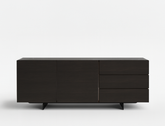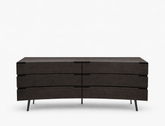HDB Design Tips for Visual Balance

When it comes to designing your HDB flat, one of the key elements that can make or break the overall aesthetic is balance. A well-balanced interior design not only looks visually appealing but also contributes to the functionality and comfort of your home. Balance in design ensures that every element, from furniture to accessories, works harmoniously together, creating a space that is both cohesive and inviting.
Walking into a room that is well-balanced immediately gives you a sense of calm and comfort. Everything seems to be in its rightful place, contributing to a good visual flow that makes the space feel cosy and welcoming. Understanding how to achieve this balance is essential for anyone looking to create a beautiful and functional living environment. Here’s how you can work with different types of balance in your HDB interior design to achieve that perfect equilibrium.
Symmetrical Balance: The Elegance of Formal Design
Symmetrical balance, often referred to as formal balance, is a design approach that involves mirroring elements on either side of a central axis. Imagine having an invisible line running down the middle of your room; everything on one side is a reflection of what’s on the other side. This style is reminiscent of a room with a large mirror, where each side looks identical to the other.
This type of balance is commonly found in classic and traditional interior designs, where symmetry is used to create a sense of order and formality. Symmetrical balance is particularly effective in living and dining rooms, where it can be used to establish inviting conversation areas. For instance, placing a large sofa on one side of the room and two matching armchairs on the other creates a balanced and aesthetically pleasing setup. An elegant coffee table in the center completes the look, pulling the entire arrangement together.
How to Achieve Symmetrical Balance in Your Living Room:
- Start with a focal point, such as a television console or a fireplace.
- Arrange furniture symmetrically around this focal point. For example, place a 3-seater sofa on one side and two matching armchairs on the other.
- Add a coffee table in the middle to anchor the space.
- Use matching decorative elements, such as lamps, vases, or wall art, on either side to enhance the symmetry.
Asymmetrical Balance: The Charm of Casual Design
While symmetrical balance is all about formality and order, asymmetrical balance offers a more relaxed and dynamic approach. Asymmetrical balance doesn’t require mirroring elements; instead, it involves mixing different design elements while maintaining a cohesive visual flow. This type of balance is more complex and can be more challenging to achieve, but when done correctly, it creates a space that feels both balanced and interesting.
In an asymmetrical design, the focus is on creating balance through contrast. For example, you might pair a large piece of furniture on one side of the room with several smaller pieces on the other side. The key is to ensure that, despite the differences in size, shape, or color, the overall composition still feels balanced.
Tips for Creating Asymmetrical Balance:
- Experiment with different furniture arrangements, such as placing a tall floor lamp next to a sofa to balance out the space.
- Use a mix of textures, colors, and patterns to create visual interest without overwhelming the space.
- Incorporate a gallery wall with various sizes of frames and artwork to add a personal touch and create a focal point.
- Anchor the room with a large rug that ties together the different elements in the space.
Radial Balance: A Stunning Focal Point
Radial balance is a less commonly used design principle, but when applied, it can create a stunning visual effect. This type of balance is achieved by arranging elements around a central focal point. The most common example of radial balance is a round dining table with chairs evenly spaced around it. The table serves as the focal point, while the surrounding chairs and other elements create a sense of balance radiating outwards.
How to Incorporate Radial Balance:
- Use a round table in your dining area, with matching chairs placed evenly around it.
- Place a chandelier or pendant light directly above the table to enhance the radial symmetry.
- Add a centerpiece, such as a vase or a decorative bowl, to the middle of the table to draw attention to the focal point.
- Consider using circular rugs or artwork to complement the radial design.
Enhancing Symmetry in Interior Design: Practical Applications
Symmetry can be applied in various ways throughout your HDB flat to create a sense of order and elegance. Here are some practical ways to incorporate symmetry into different rooms:
1. The Living Room:
- Imagine your sofa as the central focal point. Place identical chairs on either side of the sofa to create a conversation-friendly space. Add a rug and a coffee table in the center to tie the look together.
2. The Bedroom:
- Achieve a symmetrical look in your bedroom by placing matching bedside tables on either side of the bed. Add identical lamps or pendant lights to enhance the balance and create a cohesive, serene environment.
3. The Dining Area:
- Symmetry works well in dining areas too. Consider using a rectangular dining table with matching chairs on either side. A pair of identical pendant lights above the table can further enhance the symmetrical look.
Embracing Eclectic Designs: Balancing Symmetry with Playfulness
You might think that an eclectic design, with its mix of styles and elements, would only work with asymmetry. However, you can also create a balanced and harmonious space by combining eclectic elements with symmetrical design principles.
How to Achieve an Eclectic, Yet Symmetrical Look:
- Choose a statement piece, such as a colorful sofa, and surround it with complementary furniture or decor.
- Mix and match different styles, but maintain a sense of balance by arranging the elements symmetrically.
- Incorporate bookcases, gallery walls, and other decorative elements to add depth and personality to the space.
Practical Tips for Symmetry in Small Spaces
Symmetry can also be effectively used in smaller spaces, such as reading nooks, balconies, or foyers.
1. Reading Nook:
- Place two small coffee tables beside two outdoor chairs to create a cozy and balanced reading nook. Add some greenery and natural elements to complete the look.
2. Foyer:
- Make your foyer more inviting by adding a gallery wall above a slim shoe cabinet. Arrange two pieces of wall art side by side to create a symmetrical display.
3. Small Living Rooms:
- In small living rooms, opt for versatile furniture pieces, such as an L-shaped sectional paired with a single armchair or a bean bag. Add a tall side table and an extendable coffee table to anchor the space.
Additional Tips for a Balanced HDB Interior Design
Achieving the perfect balance in your HDB flat doesn’t mean sticking strictly to one design style. In fact, too much symmetry can make a space feel monotonous, while too much asymmetry can create a sense of chaos. The key is to find a balance between these two approaches, depending on the structural focal points in your space, such as walls, doors, or windows.
1. Personalize Your Space:
- Incorporate personal elements, such as family photos, art pieces, or travel souvenirs, to make your space feel truly your own.
2. Focus on High-Quality Furniture:
- Invest in high-quality furniture that not only looks good but also stands the test of time. Quality pieces can enhance the overall aesthetic and functionality of your home.
3. Experiment with Different Styles:
- Don’t be afraid to mix and match different design styles. The key is to maintain a sense of balance and harmony throughout the space.
FAQs About HDB Interior Design and Balance
Q1: What is the most important element of balance in interior design?
- The most important element of balance in interior design is ensuring that all elements in the room work harmoniously together, whether through symmetrical, asymmetrical, or radial balance. This creates a space that is both visually appealing and functional.
Q2: Can I achieve balance in a small HDB flat?
- Yes, you can achieve balance in a small HDB flat by carefully selecting and arranging furniture and decor. Use symmetry to create a sense of order and cohesion, or experiment with asymmetry to add interest and depth to your space.
Q3: How do I incorporate personal elements into a balanced design?
- Incorporate personal elements by choosing decor and accessories that reflect your personality and style. Whether it’s family photos, art pieces, or travel souvenirs, these items can add a personal touch while still maintaining a balanced design.
Q4: Is radial balance suitable for all rooms?
- Radial balance is best suited for rooms with a clear central focal point, such as a dining area with a round table. While it’s not commonly used in every room, it can create a stunning visual effect when applied appropriately.
By understanding and applying these principles of balance in your HDB interior design, you can create a space that is not only beautiful and functional but also a true reflection of your personal style. Whether you prefer the formality of symmetry or the creativity of asymmetry, the key is to find the right balance that works for you and your home.
- Bedside Table
- Bookshelves
- BTO
- Cat Friendly Sofa
- Contemporary Sofa
- Customised Sofa
- Dining Bench
- Dining Chairs
- Dining Room
- Dining Set Singapore
- Dining Table
- Entertainment Console
- Extendable Dining Table
- Fabric Sofa
- Interior Design
- L-Shape Sofa
- Leather Dining Chair
- Leather Sofa
- Mid-Century Sofa
- Modern Dining Chair
- Modern Dining Furniture
- Modular Sofa
- Pet Friendly Sofa
- Side Table
- Sideboard
- Sofa
- TV Console
- TV Stand
- Velvet Sofa
- Water Repellent Sofa
- Wooden Dining Table







